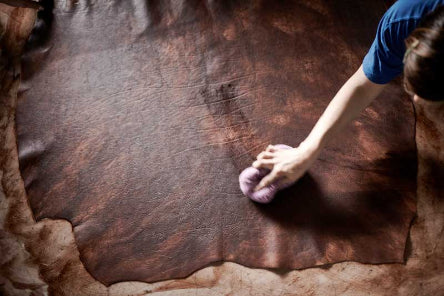Types of Leather Tanning Explained
What is Leather Tanning?
Leather tanning transforms raw animal hides into durable, long-lasting material. It protects the hides from decay and prepares them for various uses. Whether you're making belts, wallets, or handbags, understanding the tanning process can help you choose the right type of leather for your project.
Different tanning methods give leather its unique properties. Each technique has advantages and drawbacks, from traditional vegetable tanning to modern chrome tanning. Let's explore the most common methods and their characteristics.
The Basics of Leather Tanning
Tanning stabilises the proteins in the hide, preventing them from rotting and making them suitable for everyday use. Without this process, the hide would degrade quickly.
There are three main types of leather tanning:
- Vegetable tanning
- Chrome tanning
- Other methods like brain tanning or oil tanning
Each process creates leather with specific qualities that are suitable for various applications. Whether after something firm and traditional or soft and lightweight, your tanning method will impact your final product.
Vegetable Tanning: A Timeless Technique
Vegetable tanning is one of the oldest methods, dating back thousands of years. This traditional process utilises natural tannins in plants such as oak, chestnut, and mimosa. Although it requires more time than modern methods, the results yield durable and beautiful leather that improves with age.
What Makes Vegetable-Tanned Leather Special?
-
Thick and firm texture: Ideal for projects that need structure, such as belts or saddles.
-
Natural colours: Warm, earthy tones that darken over time, developing a rich patina.
-
Eco-friendly materials: No synthetic chemicals, making it a more sustainable option.
Common Uses for Vegetable-Tanned Leather
This type of leather works well for:
- Belts
- Saddles
- Knife sheaths
- Stiff wallets
- Projects requiring embossing or stamping
Things to Keep in Mind
Vegetable-tanned leather isn't water-resistant. Prolonged exposure to moisture can cause warping or damage. Due to the lengthy production process, vegetable-tanned leather costs more than other types. However, many artisans find the quality and beauty worth the investment.
Chrome Tanning: The Modern Approach
Chrome tanning, introduced in the mid-19th century, revolutionised the leather industry. Using chromium salts accelerates production, completing the tanning process in a few days rather than weeks. Chrome tanning is now the most common method, accounting for around 80–90% of all leather produced globally.
Why Choose Chrome-Tanned Leather?
-
Soft and flexible: Ideal for clothing, handbags, or other items that require comfort.
-
Vibrant colours: Offers a wide range of dye options, from subtle to bold shades.
-
Water-resistant: Better suited for outdoor use compared to vegetable-tanned leather.
Popular Uses for Chrome-Tanned Leather
This versatile leather serves a variety of purposes, including:
- Upholstery
- Shoes and boots
- Handbags and fashion accessories
- Lightweight wallets or linings
Considerations
While chrome tanning is faster and more affordable, it does have drawbacks. Unlike vegetable-tanned leather, it doesn't develop a patina over time. Environmental concerns are another issue, as the process involves using heavy chemicals that can affect ecosystems if not disposed of properly.
Exploring Other Tanning Methods
In addition to vegetable and chrome tanning, various techniques address specific needs or preferences. These include brain tanning, oil tanning, and aldehyde tanning. Although less common, these methods still hold significant importance in leather production.
Brain Tanning
This ancient method uses the natural oils in animal brains to tan hides. It creates a soft, pliable leather often used in traditional clothing like moccasins.
-
Pros: Completely natural, eco-friendly, and incredibly soft.
-
Cons: Labour-intensive and less resistant to moisture.
Oil Tanning
Oil tanning involves treating hides with fish oils, historically including whale oil. This method is commonly employed to create water-resistant leather, including nubuck and suede-like materials.
-
Pros: Soft and water-repellent, making it great for boots or gloves.
-
Cons: Limited availability and fewer colour options.
Aldehyde Tanning
Aldehyde tanning uses chemical processes to create durable, tear-resistant leather. It is often used in car interiors or medical applications.
-
Pros: Long-lasting and resistant to wear.
-
Cons: Lacks the natural beauty of vegetable- or chrome-tanned leather.
Picking the Right Leather for Your Project
Choosing the appropriate type of leather tanning depends on what you're creating, the desired look, and your budget. Here are several factors to consider:
1. What Are You Making?
-
Durable items: For belts, saddles, or shoes, vegetable-tanned leather is a solid option.
-
Soft goods: Chrome or oil-tanned leather is better for handbags, clothing, or upholstery.
2. Appearance and Feel
3. Budget
-
Affordable options: Chrome-tanned leather is often cheaper and widely available.
-
Premium quality: Vegetable-tanned leather is usually more expensive but offers unique character and craftsmanship.
4. Environmental Impact
If sustainability is a priority, vegetable or brain tanning is a cleaner alternative to chrome. These methods use fewer chemicals, reducing their ecological footprint.
Why Leather Tanning Matters
Understanding leather tanning helps you make informed decisions about your projects. Whether you value vegetable-tanned leather's natural beauty or chrome-tanned materials' convenience, knowing the basics ensures your work is functional and beautiful.
Are you ready to start your next project? Selecting the appropriate leather allows you to craft something unique that endures for years.





Leave a comment: